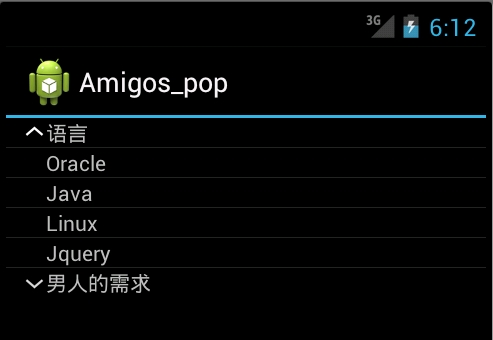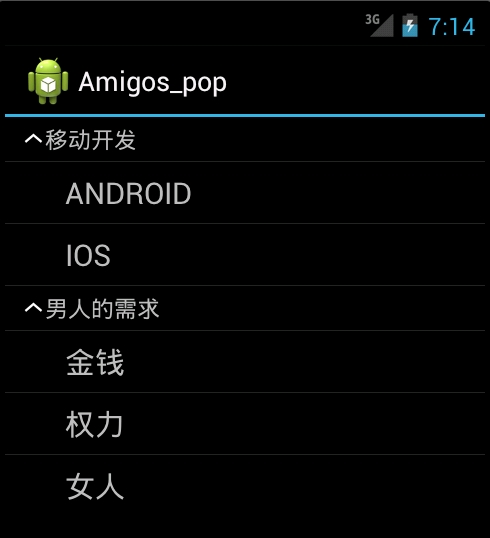首页 > 代码库 > android ExpandableListView详解(转载)
android ExpandableListView详解(转载)
ExpandableListView是android中可以实现下拉list的一个控件,是一个垂直滚动的心事两个级别列表项手风琴试图,列表项是来自ExpandableListViewaAdapter,组可以单独展开。
重要方法:
1 2 3 4 5 6 7 8 9 10 11 12 | expandGroup (int groupPos) ;//在分组列表视图中 展开一组,setSelectedGroup (int groupPosition) ;//设置选择指定的组。setSelectedChild (int groupPosition, int childPosition, boolean shouldExpandGroup);//设置选择指定的子项。getPackedPositionGroup (long packedPosition);//返回所选择的组getPackedPositionForChild (int groupPosition, int childPosition) ;//返回所选择的子项getPackedPositionType (long packedPosition);//返回所选择项的类型(Child,Group)isGroupExpanded (int groupPosition);//判断此组是否展开 |
expandableListView.setDivider();这个是设定每个Group之间的分割线。
expandableListView.setGroupIndicator();这个是设定每个Group之前的那个图标。
expandableListView.collapseGroup(int group); 将第group组收起
ExpandableListAdapter
一个接口,将基础数据链接到一个ExpandableListView。 此接口的实施将提供访问Child的数据(由组分类),并实例化的Child和Group。
1.重要方法
getChildId (int groupPosition, int childPosition) 获取与在给定组给予孩子相关的数据。
getChildrenCount (int groupPosition) 返回在指定Group的Child数目。
案例:
首先定义个一个布局文件expandablelistview.xml
1 2 3 4 5 6 7 8 9 10 11 12 | <?xml version="1.0" encoding="utf-8"?><LinearLayout xmlns:android="http://schemas.android.com/apk/res/android" android:layout_width="fill_parent" android:layout_height="fill_parent" android:orientation="vertical" > <ExpandableListView android:id ="@+id/expandableListView" android:layout_width ="fill_parent" android:layout_height ="wrap_content" > </ExpandableListView></LinearLayout> |
1 2 3 4 5 6 7 8 9 10 11 12 13 14 15 16 17 18 19 20 21 22 23 24 25 26 27 28 29 30 31 32 33 34 35 36 37 38 39 40 41 42 43 44 45 46 47 48 49 50 51 52 53 54 55 56 57 58 59 60 61 62 63 64 65 66 67 68 69 70 71 72 73 74 75 76 77 78 79 80 81 82 83 84 85 86 87 88 89 90 91 92 93 94 95 96 97 98 99 100 101 102 103 104 105 106 107 108 109 110 111 112 113 114 115 116 117 118 119 120 121 122 123 124 125 126 127 128 129 130 131 132 133 134 135 136 137 138 139 140 141 142 143 144 145 146 147 148 149 150 151 152 153 154 155 156 157 158 159 160 161 162 | package com.test;import java.util.ArrayList;import java.util.List;import javax.security.auth.PrivateCredentialPermission;import android.app.Activity;import android.os.Bundle;import android.view.Gravity;import android.view.View;import android.view.ViewGroup;import android.view.Window;import android.widget.AbsListView;import android.widget.BaseExpandableListAdapter;import android.widget.ExpandableListView;import android.widget.TextView;public class ExpandableListViewDemo extends Activity { /** Called when the activity is first created. */ //定义两个List用来控制Group和Child中的String; private List<String> groupArray;//组列表 private List<List<String>> childArray;//子列表 private ExpandableListView expandableListView_one; @Override public void onCreate(Bundle savedInstanceState) { super.onCreate(savedInstanceState);// requestWindowFeature(Window.FEATURE_NO_TITLE); //设置为无标题 setContentView(R.layout.expandablelistview); expandableListView_one =(ExpandableListView)findViewById(R.id.expandableListView); groupArray =new ArrayList<String>(); childArray = new ArrayList<List<String>>(); /*-第一季-*/ initdate(); expandableListView_one.setAdapter(new ExpandableListViewaAdapter(ExpandableListViewDemo.this)); /*-第二季-*/// groupArray.add("移动开发");// List<String> arrayList = new ArrayList<String>();// arrayList.add("Android");// arrayList.add("IOS");// arrayList.add("Windows Phone");// //组循环// for(int index=0;index<groupArray.size();++index)// {// childArray.add(arrayList);// }// expandableListView_one.setAdapter(new ExpandableListViewaAdapter(ExpandableListViewDemo.this)); } class ExpandableListViewaAdapter extends BaseExpandableListAdapter { Activity activity; public ExpandableListViewaAdapter(Activity a) { activity = a; } /*-----------------Child */ @Override public Object getChild(int groupPosition, int childPosition) { // TODO Auto-generated method stub return childArray.get(groupPosition).get(childPosition); } @Override public long getChildId(int groupPosition, int childPosition) { // TODO Auto-generated method stub return childPosition; } @Override public View getChildView(int groupPosition, int childPosition, boolean isLastChild, View convertView, ViewGroup parent) { String string =childArray.get(groupPosition).get(childPosition); return getGenericView(string); } @Override public int getChildrenCount(int groupPosition) { // TODO Auto-generated method stub return childArray.get(groupPosition).size(); } /* ----------------------------Group */ @Override public Object getGroup(int groupPosition) { // TODO Auto-generated method stub return getGroup(groupPosition); } @Override public int getGroupCount() { // TODO Auto-generated method stub return groupArray.size(); } @Override public long getGroupId(int groupPosition) { // TODO Auto-generated method stub return groupPosition; } @Override public View getGroupView(int groupPosition, boolean isExpanded, View convertView, ViewGroup parent) { String string=groupArray.get(groupPosition); return getGenericView(string); } @Override public boolean hasStableIds() { // TODO Auto-generated method stub return false; } @Override public boolean isChildSelectable(int groupPosition, int childPosition) { // TODO Auto-generated method stub return true; } private TextView getGenericView(String string ) { AbsListView.LayoutParams layoutParams =new AbsListView.LayoutParams( ViewGroup.LayoutParams.MATCH_PARENT, ViewGroup.LayoutParams.WRAP_CONTENT); TextView textView =new TextView(activity); textView.setLayoutParams(layoutParams); textView.setGravity(Gravity.CENTER_VERTICAL |Gravity.LEFT); textView.setPadding(40, 0, 0, 0); textView.setText(string); return textView; } } private void initdate() { addInfo("语言", new String[]{"Oracle","Java","Linux","Jquery"}); addInfo("男人的需求", new String[]{"金钱","事业","权力","女人","房子","车","球"}); } private void addInfo(String group,String []child) { groupArray.add(group); List<String> childItem =new ArrayList<String>(); for(int index=0;index<child.length;index++) { childItem.add(child[index]); } childArray.add(childItem); }} |
运行效果:

注释修改如下代码:
1 2 3 4 5 6 7 8 9 10 11 12 13 14 15 16 | /*-第一季-*/// initdate();// expandableListView_one.setAdapter(new ExpandableListViewaAdapter(ExpandableListViewDemo.this)); /*-第二季-*/ groupArray.add("移动开发"); List<String> arrayList = new ArrayList<String>(); arrayList.add("Android"); arrayList.add("IOS"); arrayList.add("Windows Phone"); //组循环 for(int index=0;index<groupArray.size();++index) { childArray.add(arrayList); } expandableListView_one.setAdapter(new ExpandableListViewaAdapter(ExpandableListViewDemo.this)); |
运行效果:

★★★★★★★★★★★★★★★★★★★★
案例二:
1.定义一个主界面expandablelistview.xml
1 2 3 4 5 6 7 8 9 10 11 12 | <?xml version="1.0" encoding="utf-8"?><LinearLayout xmlns:android="http://schemas.android.com/apk/res/android" android:layout_width="fill_parent" android:layout_height="fill_parent" android:orientation="vertical" > <ExpandableListView android:id ="@+id/expandableListView" android:layout_width ="fill_parent" android:layout_height ="wrap_content" > </ExpandableListView></LinearLayout> |
2.在res/drawable目录下创建样式文件expandablelistview_groups.xml该界面是组界面:
1 2 3 4 5 6 7 8 9 10 11 12 13 14 15 16 17 | <?xml version="1.0" encoding="utf-8"?><LinearLayout xmlns:android="http://schemas.android.com/apk/res/android" android:layout_width="fill_parent" android:layout_height="fill_parent" android:orientation="vertical" > <TextView android:id="@+id/textGroup" android:layout_width="fill_parent" android:layout_height="fill_parent" android:paddingLeft="40px" android:paddingTop="6px" android:paddingBottom="6px" android:textSize="15sp" android:text="No data" > </TextView></LinearLayout> |
3.在res/drawable目录下创建样式文件expandablelistview_child.xml;是子控件,直接显示列表内容
1 2 3 4 5 6 7 8 9 10 11 12 13 14 15 | <?xml version="1.0" encoding="utf-8"?><LinearLayout xmlns:android="http://schemas.android.com/apk/res/android" android:layout_width="fill_parent" android:layout_height="fill_parent" android:orientation="vertical" > <TextView android:id="@+id/textChild" android:layout_width="fill_parent" android:layout_height="fill_parent" android:paddingLeft="60px" android:paddingTop="10px" android:paddingBottom="10px" android:textSize="20sp" android:text="No Data" /> </LinearLayout> |
定义java文件:ExpandableListViewDemo_two.java
1 2 3 4 5 6 7 8 9 10 11 12 13 14 15 16 17 18 19 20 21 22 23 24 25 26 27 28 29 30 31 32 33 34 35 36 37 38 39 40 41 42 43 44 45 46 47 48 49 50 51 52 53 54 55 56 57 58 59 60 61 62 63 64 65 66 67 68 69 70 71 72 73 74 75 76 77 78 79 80 81 82 83 84 85 86 87 88 89 90 91 92 93 94 95 96 97 98 99 100 101 102 103 104 105 106 107 108 109 110 111 112 | package com.test;import java.util.ArrayList;import java.util.HashMap;import java.util.List;import java.util.Map;import javax.security.auth.PrivateCredentialPermission;import com.test.R;import com.test.ExpandableListViewDemo.ExpandableListViewaAdapter;import com.test.R.id;import com.test.R.layout;import android.app.Activity;import android.os.Bundle;import android.view.Gravity;import android.view.View;import android.view.ViewGroup;import android.view.Window;import android.widget.AbsListView;import android.widget.BaseExpandableListAdapter;import android.widget.ExpandableListView;import android.widget.SimpleExpandableListAdapter;import android.widget.TextView;public class ExpandableListViewDemo_two extends Activity { /** Called when the activity is first created. */ private ExpandableListView expandableListView_one; @Override public void onCreate(Bundle savedInstanceState) { super.onCreate(savedInstanceState); setContentView(R.layout.expandablelistview); expandableListView_one =(ExpandableListView)findViewById(R.id.expandableListView); //创建二个一级条目标题 Map<String, String> title_1 = new HashMap<String, String>(); Map<String, String> title_2 = new HashMap<String, String>(); title_1.put("group", "移动开发"); title_2.put("group", "男人的需求"); //创建一级条目容器 List<Map<String, String>> gruops = new ArrayList<Map<String,String>>(); gruops.add(title_1); gruops.add(title_2); //创建二级条目内容 //内容一 Map<String, String> content_1 = new HashMap<String, String>(); Map<String, String> content_2 = new HashMap<String, String>(); content_1.put("child", "ANDROID"); content_2.put("child", "IOS"); List<Map<String, String>> childs_1 = new ArrayList<Map<String,String>>(); childs_1.add(content_1); childs_1.add(content_2); //内容二 Map<String, String> content_3 = new HashMap<String, String>(); Map<String, String> content_4 = new HashMap<String, String>(); Map<String, String> content_5 = new HashMap<String, String>(); content_3.put("child", "金钱"); content_4.put("child", "权力"); content_5.put("child", "女人"); List<Map<String, String>> childs_2 = new ArrayList<Map<String,String>>(); childs_2.add(content_3); childs_2.add(content_4); childs_2.add(content_5); //存放两个内容, 以便显示在列表中 List<List<Map<String, String>>> childs = new ArrayList<List<Map<String,String>>>(); childs.add(childs_1); childs.add(childs_2); //创建ExpandableList的Adapter容器 /** * 使用SimpleExpandableListAdapter显示ExpandableListView * 参数1.上下文对象Context * 参数2.一级条目目录集合 * 参数3.一级条目对应的布局文件 (expandablelistview_groups.xml文件 * 参数4.fromto,就是map中的key,指定要显示的对象 * 参数5.与参数4对应,指定要显示在groups中的id * 参数6.二级条目目录集合 * 参数7.二级条目对应的布局文件 * 参数9.与参数8对应,指定要显示在childs中的id / SimpleExpandableListAdapter adapter = new SimpleExpandableListAdapter( this, gruops, R.drawable.expandablelistview_groups, new String[]{"group"}, new int[]{R.id.textGroup}, childs, R.drawable.expandablelistview_child, new String[]{"child"}, new int[]{R.id.textChild} ); //加入列表 expandableListView_one.setAdapter(adapter); expandableListView_one.setOnChildClickListener(listener); } private OnChildClickListener listener =new OnChildClickListener() { @Override public boolean onChildClick(ExpandableListView parent, View v, int groupPosition, int childPosition, long id) { // TODO Auto-generated method stub toast("点击了"); return false; } }; private void toast(String str) { Toast.makeText(this, str, Toast.LENGTH_LONG).show(); } } |
上面的样式也可以使用系统的自带的样式如下:
android.R.layout.simple_expandable_list_item_1,//层显示样式 ,系统自定义
android.R.layout.simple_expandable_list_item_2,
运行效果:

案例三:如果group中有个ImageVIew将会是什么情况呢?
在SimpleExpandableListAdapter中有如下方法:
1 2 3 4 5 6 7 8 9 10 | private void bindView(View view, Map<String, ?> data, String[] from, int[] to) { int len = to.length; for (int i = 0; i < len; i++) { TextView v = (TextView)view.findViewById(to[i]); if (v != null) { v.setText((String)data.get(from[i])); } } } |
从上面的方法中可以看出 SimpleExpandableListAdapter把所以的View都当成TextView来处理了,而不像SimpleAdapter可以自动判断View的类型,自动绑定,解决版本就是重写bingview回调一下试试:
1 2 3 4 5 6 7 8 9 10 11 12 13 14 15 16 17 18 19 20 21 22 23 | public class MyExpandableListAdapter extends BaseExpandableListAdapter{ private void bindView(View view, Map<String, ?> data, String[] from, int[] to) { int len = to.length; boolean isBound = false; for (int i = 0; i < len; i++) { final View v = view.findViewById(to[i]); if (v!=null) { final Object _data = http://www.mamicode.com/data.get(from[i]); String text = _data =http://www.mamicode.com/= null ? "" : data.toString(); if (text == null) { text = ""; } if (mViewBinder != null) {//如果Binder不为空,使用Binder进行处理 isBound = mViewBinder.setViewValue(v, data.get(from[i]), text); } if (!isBound) {//如果Binder跳过,使用原来的方法进行处理 TextView _v = (TextView)v; _v.setText((String)data.get(from[i])); } } } }} |
android ExpandableListView详解(转载)
